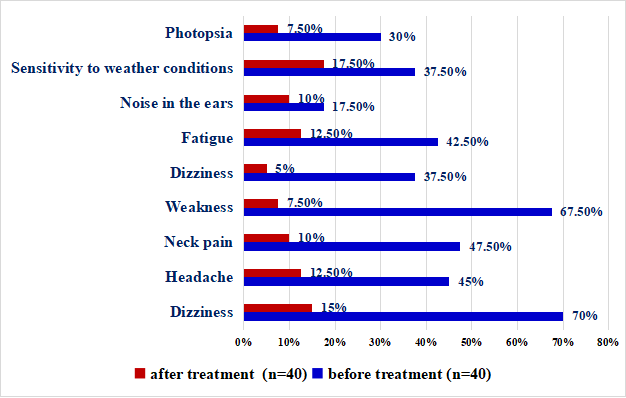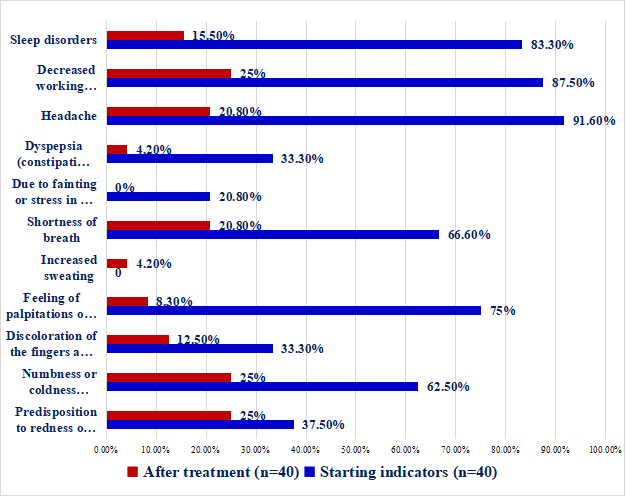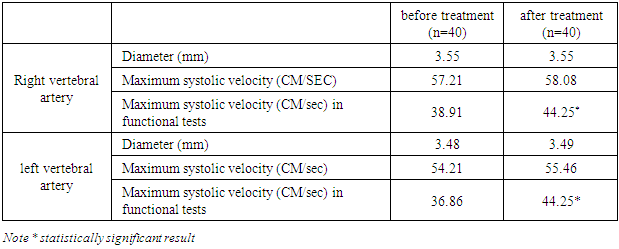-
Paper Information
- Next Paper
- Previous Paper
- Paper Submission
-
Journal Information
- About This Journal
- Editorial Board
- Current Issue
- Archive
- Author Guidelines
- Contact Us
American Journal of Medicine and Medical Sciences
p-ISSN: 2165-901X e-ISSN: 2165-9036
2025; 15(3): 637-641
doi:10.5923/j.ajmms.20251503.32
Received: Jan. 25, 2025; Accepted: Feb. 22, 2025; Published: Mar. 10, 2025

Effects of Physiotherapy Treatment for Spinal Artery Syndrome
Saidov Sukhrob Rustamovich, Urinov Muso Boltaevich
Bukhara State Medical Institute, Uzbekistan
Correspondence to: Saidov Sukhrob Rustamovich, Bukhara State Medical Institute, Uzbekistan.
| Email: |  |
Copyright © 2025 The Author(s). Published by Scientific & Academic Publishing.
This work is licensed under the Creative Commons Attribution International License (CC BY).
http://creativecommons.org/licenses/by/4.0/

The purpose of the study: Determination of the effect of physiotherapy procedures in patients with the observed vertebral artery syndrome. Materials and methods. The study involved patients aged 18 to 44 years. Theoretical analysis and generalization of information sources on the topic of scientific research within the framework of the study, O.M. Clinical assessment of vegetative diseases, comprehensive ultrasound examination of the blood vessels of the head and neck with a vein examination to identify signs of vegetative changes. Results. Physiotherapy helps to restore the volume of active movements of the cervical vertebrae (r<0.05). On average, 75% of patients reported the disappearance of the main symptoms, while the rest noted a decrease in their nature. During functional tests, the rate of systolic blood flow in the cerebrospinal arteries increased (r < 0.05). Conclusion: the results of the study show that the use of physiotherapy procedures in patients with the observed spinal artery syndrome helps to reduce the clinical picture of the disease, restore proper spinal biomechanics and improve blood flow in the spinal arteries.
Keywords: Physiotherapy, Vertebral artery syndrome, Isometric muscle relaxation, Neck biomechanics, Neck goniometry, Ultrasound examination of vertebral arteries
Cite this paper: Saidov Sukhrob Rustamovich, Urinov Muso Boltaevich, Effects of Physiotherapy Treatment for Spinal Artery Syndrome, American Journal of Medicine and Medical Sciences, Vol. 15 No. 3, 2025, pp. 637-641. doi: 10.5923/j.ajmms.20251503.32.
Article Outline
1. Introduction
- Vertebral artery syndrome is a combination of a number of different vascular, vestibular, traumatic, and vegetative diseases accompanied by narrowing of one or both vertebral arteries. This is observed with painful migraines, hearing, vision, and consciousness disorders, and can lead to stroke, disability, irreversible brain damage, and disability. Patients with this diagnosis go beyond the usual rhythm of life for a long time, lose their ability to work and need qualified treatment. But in order for it to be successful, it is important to clearly identify the cause of the development of vertebral artery syndrome and monitor it.
2. Relevance
- Economic losses due to disability of patients with vertebrogenic pathology occupy the first place among all diseases of the nervous system [1,2]. Ensuring proper biomechanics of the body is an integral part of the functioning of the whole organism and an important indicator of health [3]. There have been changes in the living conditions of modern humans, manifested in urbanization, low physical activity, changes in nutrition and food quality, as well as the introduction of digital technologies in all areas of life. Nowadays, with the widespread adoption of gadgets, he works for a long time in the forced position of the head and body [4]. This, in turn, causes mechanical stress on the cervical spine and leads to a number of disorders of the biomechanics of the spine. Prolonged flexion of the cervical spine is an important mechanical risk factor for chronic neck pain and increases compression of the cervical spine by 1.6 times compared to neutral [5,6,7]. Constant stable compression of the cervical spine is one of the functional factors causing deformation of the vertebral arteries and, consequently, reducing blood flow through these arteries [8]. The weakness of the vertebral artery to deformation during prolonged blood circulation of the cervical spine in full, which leads to impaired blood flow and possible Vertebrobasillary anatomical relationships of the suboccipital vertebral artery, in particular, a decrease in diameter during ipsilateral blood circulation of the cervical spine was sufficient to lead to impaired blood flow. In these patients, there was no significant effect of stretching the vertebral artery during contralateral rotation. Narrowing of the reflex, compression of the vertebral arteries and their deformation manifest themselves as vertebral artery syndrome, which includes a complex of cerebral, vascular and autonomic syndromes [9,10,11]. The development of Vertebrobasillary insufficiency in young people, which occurs against the background of pathological biomechanical changes in the cervical spine, inevitably affects the quality of life, which (according to WHO) is an integral characteristic of the patient's physical, psychological, emotional and social activity based on subjective perception [12,13,14,15].The main pathogenetic mechanism of spinal artery syndrome is compression of the arterial trunk, narrowing of the vascular cavity due to the autonomic plexus and reflex spasm, which reduces blood flow to the back of the brain, followed by the development of cerebral insufficiency.
3. The Aim of the Study
- The aim of the study was to determine the effect of physiotherapy procedures on patients with the observed vertebral artery syndrome.
4. Materials and Methods
- 40 patients with vertebral artery syndrome aged 18 to 44 years participated in the study. A research plan has been developed to achieve the purpose of the study. This made it possible to obtain fairly complete and reliable information about each task, as well as to complete them sequentially. During an objective examination of patients, the volume of active movements in the cervical spine was determined. Goniometry allows you to assess the volume of movements in the cervical spine, determine flexion, extension, left-sided and right-sided flexion and rotation in the cervical spine. When assessing movements in the cervical spine, a special protractor was used.In addition to neurological and general clinical examination, O is used in the assessment of vegetative diseases. M. Wayne introduced the "examination for signs of vegetative changes. A score of more than 15 points indicated the presence of autonomic dysfunction.All patients underwent a comprehensive ultrasound examination of the vessels of the head and neck, which included duplex scanning of these vessels using standard ultrasound and functional tests with head rotation. All subjects underwent duplex scanning of blood vessels as part of standard treatment using functional vertigo tests before and after applying a comprehensive program of physiotherapy procedures. The velocity parameters of the blood flow, i.e. the maximum blood flow rate, have been changed. The study also included functional tests that included head tilts back and forth and right and left. The physiotherapy program included therapeutic gymnastics, therapeutic and preventive exercises, postisometric muscle relaxation and light physical exercises to eliminate functional blocks in the spinal and motor segments of the cervical spine. Physiotherapy procedures were performed three times a week in the form of symmetrical, asymmetric and perturbative exercises, developed individually for each patient, taking into account the characteristics of the figure and, accordingly, the biomechanics of the spine. Therapeutic sessions usually lasted up to 30 minutes, and the course of physical therapy lasted 4 weeks.
5. Results
- All subjects underwent clinical examination, cervical spinal goniometry, comprehensive ultrasound of the vessels of the head and neck. Vegetative state o. M. It was identified by Wayne using a "survey to identify signs of vegetative change". Subjects were found to have hemodynamic disorders in cerebral arteries of varying degrees. All examinations were carried out before the start of the physiotherapy course and after the end of the physiotherapy course, which lasted 4 weeks. Among the study participants, the main complaints are weakness (87.5%), dizziness (83.3%), headache localized in the neck and back of the head, spreading forward and exacerbated by head movements (75%), neck pain in the shoulder and arm (45%), dizziness (70%). In addition, patients complain of fatigue (42.5%), photopsies (51.9%), weather sensitivity (41.6%) and noise in the ear (31.2%) (Table 1). Complaints of dizziness after a course of physiotherapy disappeared in 92% of patients, weakness - in 86%, neck pain - in 56%, photopsia – in 23%, dizziness - in 55% and headache – in 30%. A similar trend was observed with the loss of complaints such as noise in the ear in 57% and weather sensitivity in 25%. The remaining subjects showed fewer symptoms (Figure 1).
|
 | Figure 1. Dynamics of the frequency of subjective symptoms among the study participants |
|
 | Figure 2. O. M. Determination of signs of vegetative changes based on the results of Wayne's examination before and after physiotherapy treatment |
6. Conclusions
- Reflex narrowing, compression of the vertebral arteries and their deformation manifest themselves as vertebral artery syndrome, which includes a complex of cerebral, vascular and autonomic syndromes. Physiotherapy procedures for vertebral artery syndrome give a positive result, which was confirmed by the loss or decrease of clinical manifestations of this pathology, confirmed by ultrasound, goniometry and studies of autonomic functions.
 Abstract
Abstract Reference
Reference Full-Text PDF
Full-Text PDF Full-text HTML
Full-text HTML
